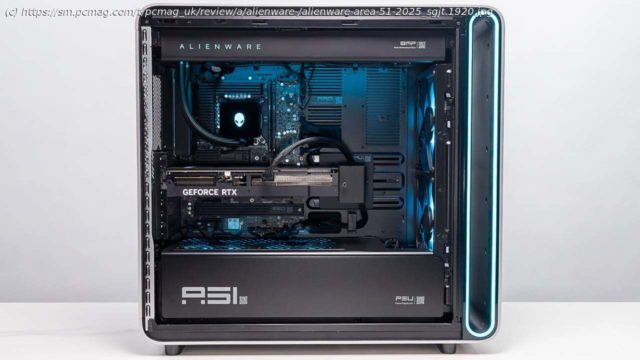The latest Area-51 reboots Alienware’s signature gaming desktop with a sleek new look, an RTX 50-series GPU, an ultra-quiet design, and only a few prebuild-specific caveats.
Alienware’s Area-51 marquee desktop line, which has demonstrated cutting-edge components and design for decades, has returned with its latest envelope-pushing 2025 model (starts at $3,749.99; $4,649.99 as tested). This redesign is big, bold, and sleek, with a distinctly futuristic look outside and RTX 50-series graphics plus Intel Core Ultra 200 processing inside. Our RTX 5080 model produces potent overall performance while remaining super quiet, thanks to its impressive positive pressure airflow system. While it uses mostly industry-standard parts, upgrading your motherboard in the future will require special accessories from Alienware, which complicates the process. Regardless, this is a big step for Alienware toward upgradability from its previous systems. At the same time, it’s fast and well-made in the present if you’re an enthusiast seeking your conversation-piece PC. For high-end gaming, our Editors’ Choice award still sits with the Corsair One i500, but this is one slick tower.Configurations: GeForce RTX 50 GPUs Touch Down
Between the powerful parts and the advanced design (which I’ll get to next), the Area-51 is a premium gaming PC through and through: It’s big and bold, and all its configurations are expensive. Area-51 launches have marked generational component leaps in the past, and this new-edition overhaul arrives alongside Nvidia’s GeForce RTX 50-series graphics cards, plus some relatively recent processor platforms.
Next to the Area-51’s redesign, these new “Blackwell” GPUs are the highlight—we’ve reviewed these cards (like the ultra-high-end Nvidia GeForce RTX 5090 and Nvidia GeForce RTX 5080) on their terms and are starting to see them roll out in prebuilt systems like this. On the processor side, Alienware went with Intel’s Core Ultra 200-series “Arrow Lake” chips.
While closer-to-entry-level graphics card options will be available for the Area-51 in the near future, the base model currently comes with an RTX 5080. It also includes an Intel Core Ultra 7 265 processor, 32GB of memory, and a 1TB solid-state drive for $3,749.99.
Our review model is configured up from that point, packing the RTX 5080, a Core Ultra 9 285K processor, 64GB of RAM (two sticks of 32GB DDR5), and a 2TB SSD for $4,649.99. This increase requires stepping up from an 800-watt, Gold-rated power supply and a 240mm liquid CPU cooler to a 1,500W Platinum-grade PSU along with a 360mm cooler. As you can imagine, the RTX 5090-based version sees the price skyrocket further, up to $5,499.99.
The RTX 5090-based model requires the 1,500W PSU for enough total system power, but you can configure an RTX 5080-based model with a lesser 850W Gold PSU and/or a 240mm cooler. Once you select the Core Ultra 9 285K, though, the configurator demands you switch to the higher-end options. The system also supports a 420mm aftermarket cooler, should you want to buy and install one yourself.Design: Standard Space-Age Style
Since its debut in the late 1990s, the Area-51 desktop has seen some bold designs, each a product of its time, but I think this is the sleekest yet. Past editions had more aggressive styling, while this leans into the sci-fi minimalism that we’ve seen the last few years—you can see the beginnings of this style in the Alienware Aurora R16.
Maybe one day I’ll look back and think that this system seems decidedly “2025,” but this desktop is meant to stand out. I should note that this review unit is not our first look at this system—we saw the tower at Dell’s CES 2025 preview event—but now we can get up close and personal with the details and the innards. Below is a lineup of past Area-51 systems from this event.
The new model’s most eye-catching attractions are the plain metal front panel, the illuminated RGB loop, and a tempered glass side panel. The lighting loop is a decidedly modern inclusion, reflecting the future aesthetic Alienware has gradually leaned toward over the years. The overall style is clean, and the interior (almost entirely visible through the window) is immaculately assembled.
This tower is also big: it measures 22 by 9 by 24 inches (HWD), has a significant footprint, and weighs up to 76 pounds, depending on the configuration. Our system feels as heavy as that sounds and should ideally be moved by two people.
Access to the interior deserves special commendation because it’s one of the simplest mechanisms I’ve used. A dial on the system’s rear side turns from locked to unlocked, allowing you to release the side window with one press of a rear button. The window (or other side panel with a different button) immediately comes free of the case and is easily lifted away. (It won’t fall to its side if you don’t catch it immediately.) This setup is one of the best implementations of tool-less access I’ve encountered.
For connectivity, the top panel houses two USB Type-C ports, two USB 3.






